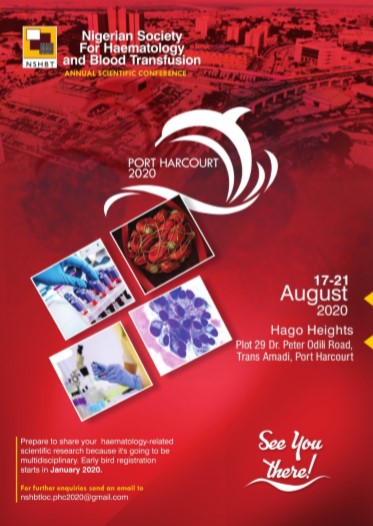Guidelines for the Management of Venous Thromboembolism In Nigeria
Abstract
Preamble The field of medicine has become so wide and the care and management of different conditions is transcending basic knowledge and requires guidelines for diagnosis, and prevention of several disease entities. Levels of medical practice differ from community to community and from one country to another. This is largely due to the fact that advancement in medical knowledge particularly diagnostic advancement and affordability of novel therapeutic interventions vary widely. The subject of thrombosis has not received sufficient attention in medical practice in Nigeria. There are very few Haematologists in Nigeria today with special interest or sub- specialization in haemostasis (haemorrhagic and thrombotic disorders), thus few research efforts have been recorded in this subject area. Review of project dissertations to the National Postgraduate Medical College of Nigeria (NPMCN) amongst fellow pathologists show that very few theses are submitted related to the subject of haemostasis. Whereas, in many countries including some African countries, the epidemiology of thrombosis and thrombotic disorders (including the burden of the diseases, the common acquired predisposing factors as well as inheritable predisposing factors) have been well documented, no such data (particularly- countrywide based) is available for Nigeria. The available literature from Nigeria is scanty and fragmented. We have no clear idea of the burden of thrombotic disorders in Nigeria, although we know from medical practice that several deaths post-surgery are related to thrombotic disorders. A number of cases of sudden deaths are diagnosed at post-mortem as being due to complication of thrombotic disorders. It is estimated from few hospital-based studies in Nigeria that inheritable predisposing factors to thrombosis may not be that rare. Factor V Leiden has been documented in at least 2% of normal blood donors in Nigeria1, other studies have shown that Protein C, Protein S, Plasminogen Activator Inhibitor levels deficiency may not be rare in 2,3 Nigeria . As part of its responsibility to Nigerians, the NSHBT is in a position to provide guidelines for prevention, diagnosis, care and treatment of diseases related to Haematology and Immunohaematological practice in Nigeria. With the support of few pharmaceutical companies in Nigeria, the Society has been able to produce Lymphoma Treatment Guidelines in Nigeria; this has undergone 1 a few updates in the recent past . At the Society's 42nd annual scientific and general meeting held in October 2016 in Lagos, the subject of thrombotic disorders in Nigeria came to fore and the Society received guests from the International Society on Thrombosis and Haemostasis (ISTH). During the conference, different aspects of thrombotic disorders were discussed, limitations in the country were identified with respect to diagnostic capacity, monitoring of anticoagulant therapy and affordability of newly available therapeutic intervention to Nigerians who suffer from thromboembolic disorders. At this conference ISTH charged and challenged Nigerian Haematologists to set up a Committee that should be saddled with the responsibility of: 1. Promoting research on thrombosis and bleeding disorders 2. Promoting increased level of exposure and training of its members in thrombotic and bleeding disorders and 3. Producing treatment guidelines for use by practitioners in Nigeria for thromboembolic disorders. We thank the ISTH for its attendance at our meeting in the persons of Prof. Andreas Greinacher from Germany, Prof. Suikish Nair from India, Dr. Edoghogho Olayemi from Ghana and Dr. Claire Mclintock from New Zealand. We also appreciate some senior Haematologists in Nigeria who have shown interest in thrombosis and Haemostasis. In particular Prof. Etim Essien a retired Professor of Haematology and blood transfusion, Prof. Wuraola Shokunbi of University College Hospital Ibadan and the energetic Prof. Omolade Awodu of the University of Benin who is the Chairman of this guideline writing Committee and the eye of Nigeria at International fora in thrombosis and haemostatic disorders. This is the first effort in developing a guideline for the prevention, diagnosis, care, treatment and prophylaxis for thromboembolic disorders in Nigeria. This guidance is written according to the current best practices as published. However every patient should be evaluated as a person and therapy should be individualized THIS GUIDELINE IS REVIEWED BY EXPERTS IN THROMBOSIS AND BLEEDING DISORDERS OF THE EDUCATION SUBCOMMITTEE OF THE INTERNATIONAL SOCIETY ON THROMBOSIS AND HAEMOSTASIS
Downloads
Downloads
Published
Issue
Section
License
Copyright (c) 2023 Nigerian Journal of Haematology

This work is licensed under a Creative Commons Attribution-NonCommercial 4.0 International License.








